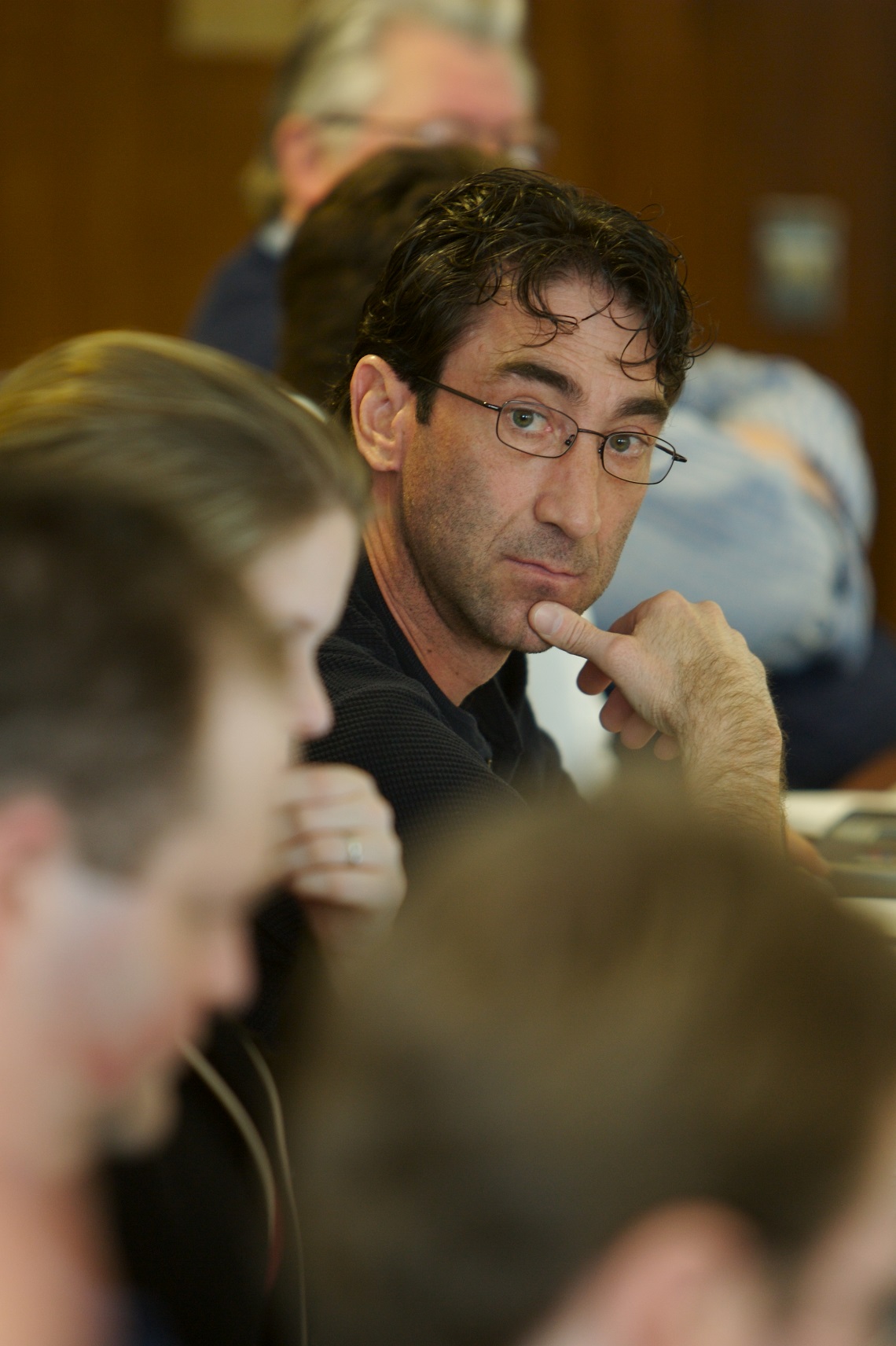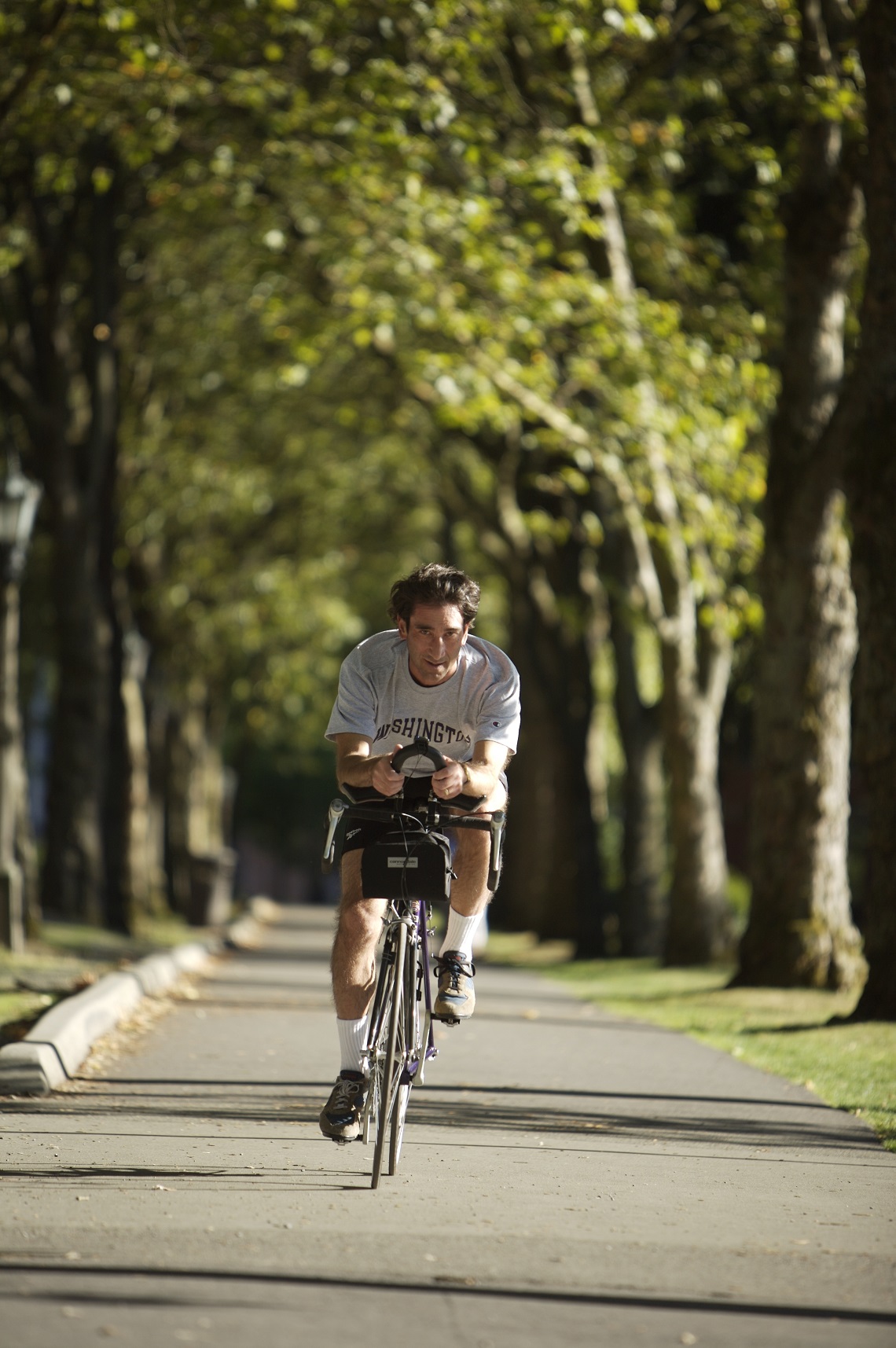Waiting To Inhale
Nearly 15 years after receiving a rare double-lung transplant, Ken Price treasures every new day—and every breath he takes
If you didn’t know who he was and what he’d been through, Ken Price (MBA 2007) would have cut an unremarkable figure that day 14 years ago, just another spindly cyclist stamping his pedals up a steep neighborhood hill. He’d have appeared no less ordinary when he stopped at the summit, leaned heavily on the handlebars and gulped deep draughts of air until the heaving of his chest gradually subsided to a tranquil resting cadence. Just like anyone else.
But that look on his face as he caught his breath, you would never have forgotten it: a pure expression of relief, of thanks, of triumph, of hope.
This was no casual ride.
And Ken Price is no ordinary guy. A former aerospace engineer now marketing the latest Boeing planes around the globe, Price has been living—vigorously—with a double-lung transplant for more than 14 years. That’s nine longer than the average recipient.
Trouble since the day he was born
Price was born with cystic fibrosis, a hereditary disease marked by a gradual deterioration of the lungs and pancreas until death, which arrives, on average, at age 37.
He was diagnosed when he was one year old. But his respiratory problems were slow to materialize. Through high school and college, Price played soccer and tennis competitively. His intellectual life was equally robust. He graduated from Cornell in 1985 with a degree in mechanical and aerospace engineering, then powered to a masters in aeronautics and astronautics at Stanford the next year. After a year working for McDonnell Douglas in California, Price began a long relationship with Boeing.
It was not until his early 20s that his lungs began to decline along the normal plot of a cystic fibrosis patient. Doctors controlled bouts of infection in his lungs with antibiotics for a while, before his body became resistant. “Once that happens,” he explains, “the infection scars your lungs. And that’s when you are in trouble.”
By his late 20s, Price was chronically ill. His once athletic build became frail with atrophy. He was dying. “I was to the point where I couldn’t catch my breath—sitting still—without bottled oxygen,” he recalls.
Having exhausted all other options to treat his cystic fibrosis, Price began applying to hospitals around the country for a double-lung transplant. Few were performing this risky procedure in the early 1990s, and those that were denied his request. “Everyone turned me down,” he recalls. “I had no hope.”
One last chance
In January 1993, the University of Washington Medical Center began a lung transplant program for cystic fibrosis patients. Taking the odds of a successful transplant on top of the odds of even finding a donor match, his prognosis did not look good. Didn’t bother Price. “I was getting sicker, probably not too far from dying,” he recalls. “My odds were zero. So even if a transplant improved my odds to ten percent, I was thrilled.
“I had this weird sense, this faith, that if the UW listed me for a transplant—and if I lived long enough to get my lungs—that it was going to work.”
Six months after being listed, a donor emerged. Price received his transplant. But then everything that could go wrong did go wrong. “As soon as I woke from the surgery, I felt like I had been hit by a truck,” he says.
The new lungs collapsed and Price suffered massive internal bleeding. Surgeons had to re-open his chest to drain the hemorrhage. When he came out of the second surgery, though, Price was more than alive.
Less than a month later, he gingerly stepped onto a tennis court for the first time in years. That went so well that he decided to follow it up with a casual ride on his bicycle that ascended to his moment of epiphany: “I was cruising around my neighborhood slowly and thinking, okay, I can breathe. Then I came to this big hill. I had to go for it. So I just pounded up that hill. And I did get out of breath, like any normal person would. But when I reached the top, I stopped and caught my breath within a minute, like a normal person. It was an amazing moment. I’ll never forget this. I remember saying, they work.”
Back to work
Price felt so good on the bike that he rode the 200-mile Seattle To Portland tour the very next year, and many times since. He also dove back into his work at Boeing. Over the next years, he worked on engineering wings, engines, flight tests and flight operations. He left for a few years to help lead a small jet development team at Embraer in Brazil, then began work on a Honeywell military program in New Mexico when the call-back came from Boeing. As the company was gearing up to launch its celebrated new 787 Dreamliner, they wanted Price back. To his surprise, the offer was in sales and marketing: regional director for fleet revenue management.
Price is more than capable—and more than happy—to be evangelizing this engineering marvel and the enlightened customer experience it stands to afford even coach passengers. The 787 promises to revolutionize the flying experience. Its vaulted architecture, capacious interior, dilated windows, serene lighting and terrestrial cabin atmosphere may hold mankind’s best hope for pleasurable flight.

But if his new position was a healthy marriage of a rich engineering background, natural charisma and an innate business sense, Price knew that he still had much to learn. “I realized that though my technical education and work experience were strong, in my new role understanding business knowledge in-depth would be critical,” he says. “And I knew that if I wanted to accelerate my new career and really become a leader, I needed to get an MBA.”
Price was accepted to the Foster School’s Executive MBA Program in 2005, and qualified for one of the few full-ride scholarships that Boeing extends to promising young executives. He graduated class valedictorian, even as he traveled the world for Boeing.
And he does travel, as much as a quarter of the year, to all points on the planet. It’s a schedule that would be taxing even if he weren’t living on borrowed lungs.
Exercising for life
When a double-lung transplant recipient dies, it is usually due to rejection or infection. Managing treatment of these two perils is a delicate balancing act. The drugs that prevent rejection suppress the immune system and increase the risk of infection.
In all his years of intercontinental flights and the resulting circadian confusion, Price has managed to ward off most infection and suffered zero episodes of rejection. “I’m fortunate because I got this amazing match,” he says. “Plus I treat myself well, get plenty of rest and drink a lot of water. And I really work my lungs.”
That’s an understatement. Whether in Seattle, Frankfurt, Bangkok or Buenos Aires, Price exercises daily with the intensity of an elite endurance athlete.

His regimen rotates from tennis to racquetball to biking to running—on a hotel treadmill if he’s strapped for time. “I work out to exhaustion every day,” he explains. “I have this innate sense that if you expand your lungs and get the air and blood moving through them, they are going to come through for you.”
“I’m able to exercise because my transplant works well,” he adds. “But I think my transplant works well because I exercise.”
The luxury of dreaming
Remarkably still thriving in his 15th year with a new pair of lungs, Price even allows himself to dream about the future. And his dreams are not at all modest. Along with the help of partner Scott Lentz (MBA 2007), the CFO of Picis and a member of his EMBA study team, Price hopes someday to launch Cardea, a high-touch airline serving business class travelers exclusively.
The unveiling of these latent entrepreneurs was a slow affair. It began with a fictional all-business-class airline they conjured for projects in marketing and managerial accounting classes. When pressed to come up with an entry for the mandatory EMBA Business Plan Competition, Price & Co. decided to sketch their little mythical airline into a full-blown business plan.
It wasn’t that simple, of course. But leveraging Lentz’s financial knowledge and Price’s insight into engineering and operations, Cardea (“goddess of the wind”) was compelling enough to win the competition.
Price and Lentz are not ready to quit their day jobs just yet. But they have refined their plan significantly. In their vision, Cardea will provide business travelers door-to-door limo service, expedited check-in and security, and specially engineered and appointed 757s that provide all the frills of an executive jet. Routes will directly connect strategic, underserved locales to popular business hubs—say, West Palm Beach to Paris or San Jose to London. And all at rates competitive with existing business class travel.
The price tag to get off the ground? Around $40 million. But based on unexpectedly positive feedback from investors and airline executives, Price figures the probability of financing is somewhere north of impossible, odds he is comfortable with.
“On the small chance that someone would say, ‘Yeah, I believe in this idea and I have an extra $40 million to give you,’ ” he says, “it would be hard to turn down the opportunity to run your own airline.”
Until then, it’s enough to have dreams, and options to back them, luxuries that used to be as elusive as an unfettered breath of air.
“Risk doesn’t bother me,” Price says. “If you look at the stakes of this idea not working versus my lung transplant not working, it’s small peanuts. After what I’ve been through, my view is that as long as I wake up tomorrow, I can fix whatever is wrong in my life.
“If you wake up tomorrow, you have everything.”
